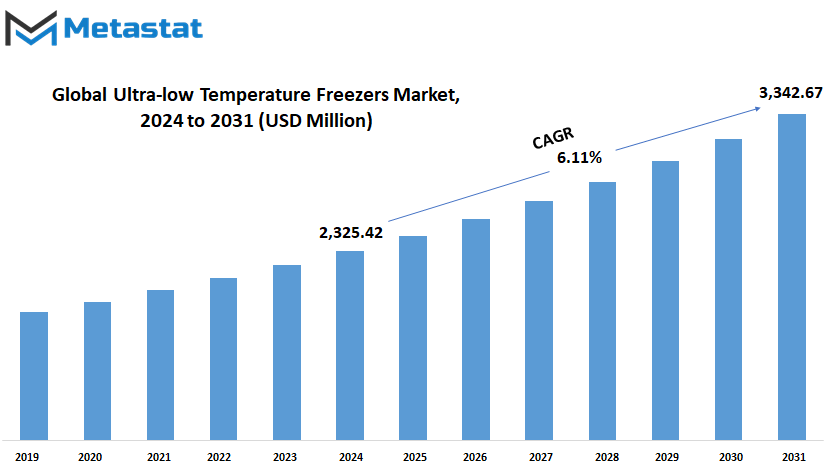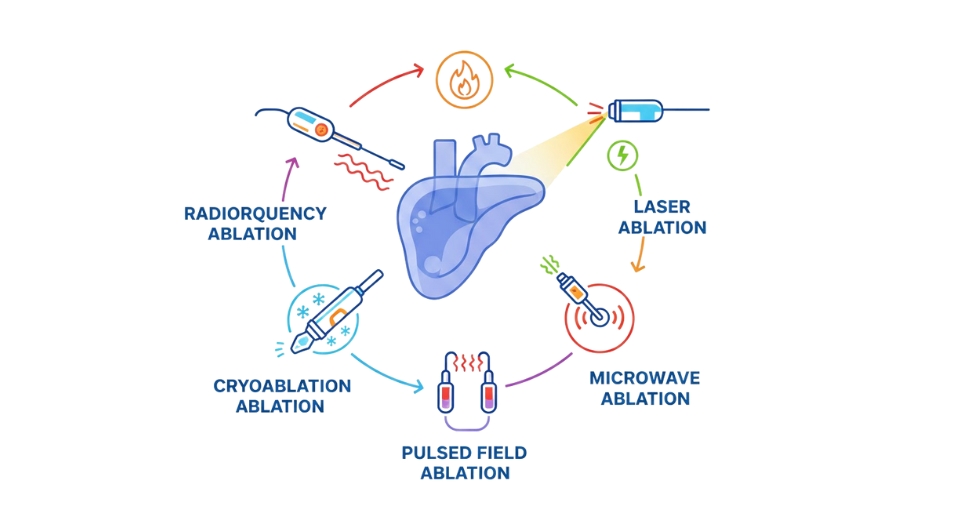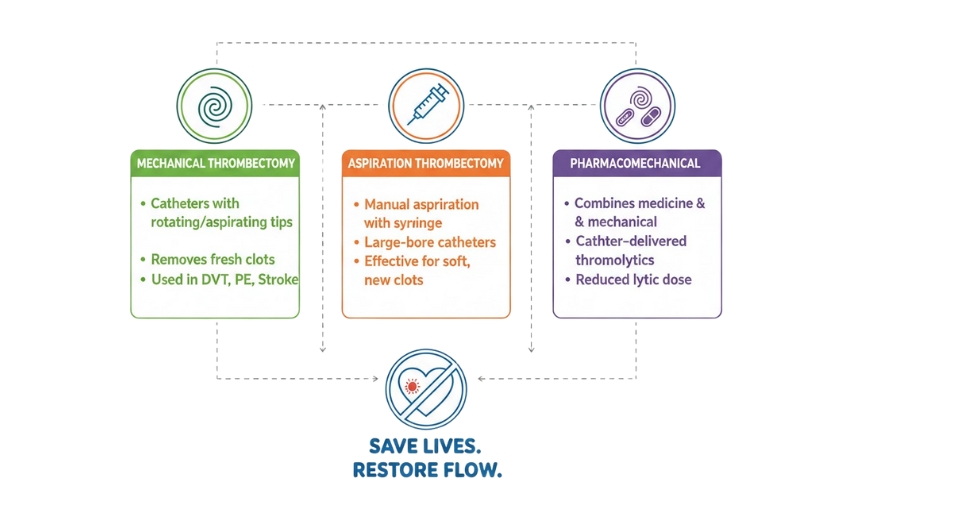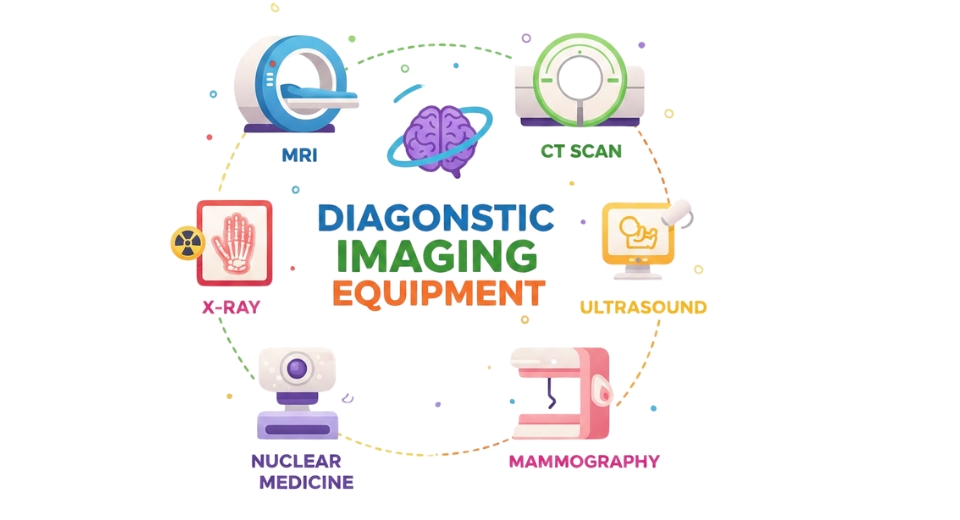MARKET OVERVIEW
The Global Ultra-low Temperature Freezers market is a niche area of the overall refrigeration industry that has evolved specifically to satisfy the severe need for advanced storage solutions across various scientific, medical, and industrial applications. ULT freezers are designed for storing biological samples, pharmaceuticals, and other sensitive materials at extremely low temperatures ranging from -40°C to -86°C. These freezers ensure specimens remain long-term viable and are protected from degradation because of temperature fluctuations or environmental conditions.
This market has been very popular because of the necessity for preservation of biological materials like vaccines, enzymes, cell cultures, and genetic materials. Since the interest in scientific research, biotechnology, and pharmaceuticals is increasing, the demand for ultra-low temperature freezers will increase steadily in the future. From highly advanced lab and research storage facilities to hospitals everywhere, ultra-low temperature freezers hold the integrity of the sample and product for many organizations. Rules designed to contain the storage of biologics and other temperature-sensitive material emphasize the importance of ultra-low temperature freezers.
Some products which would emerge from this market of Ultra-low Temperature Freezers Market – Global would include specific lines and technologies based on particular needs of various customers. Some of these come in uprights and chest freezers offering different benefits in terms of capacity and ease of access besides optimum utilization of space. Companies have the culture of investing in Research and Development to enhance performances of ULT freezers. The innovations include improved efficiency in consuming energy, being environment friendly, and achieving perfect temperature uniformity. With growing environmental concerns, a trend in green refrigeration technologies and low global warming potential refrigerants is expected across the industry. The Geographic regions covered under the Global Ultra-low Temperature Freezers are North America, Europe, Asia-Pacific, and Rest of the world.
Advanced healthcare infrastructure and heavy investment in research and development activities will maintain dominance in North America and the European regions. Market growth will come from emerging economies in Asia-Pacific and Latin America due to increased investments in biotechnology and pharmaceutical manufacturing. This is quite a large scope for the players to extend their footprints and satisfy the ever-increasing demand for advanced storage solutions in those regions. The Global Ultra-low Temperature Freezers market is still relatively competitive. Various manufacturers fight for shares in terms of product differentiation and service offering. The prominent manufacturers are directly competing against each other due to new features, networking distribution, and customer care facilities. Such a competitive business environment does indeed change with time through evolving technology, changing customer demand, and regulatory conditions in the sector.
The years that follow will be significant for the Global Ultra-low Temperature Freezers market in promoting further development in healthcare, life sciences, and industrial processes. As the demand for storage solutions increases, the industry is going to evolve into greater sustainability, energy efficiency, and technology innovations. By working through such challenges and opportunities, stakeholders will contribute to the development of a strong, globally networked market that can service an increasingly.
Global Ultra-low Temperature Freezers market is estimated to reach $3,342.67 Million by 2031; growing at a CAGR of 6.11%% from 2024 to 2031.

GROWTH FACTORS
The Global Ultra-low Temperature Freezers (ULT) market will see much growth in the near future. There has been increasing demand for these freezers, used to store biological samples at very low temperatures. A number of key drivers include rising needs for ultra-low temperature storage in the biopharmaceutical and healthcare industries. With the ever-growing demand for vaccines and especially in the light of global health crises, there is a need for safe and dependable storage solutions. This is exactly what ULT freezers offer, being also important for research - vaccine development, medicines, and other treatments, among others, require very tight temperature control.
Further, increased research activities in genomics, proteomics, and stem cell preservation have greatly been demanding ultra-low temperature storage. The demand for such proper storage increases with the continuation of scientific research in these areas. Such biological samples as DNA, proteins, and stem cells are required to be maintained at ultra-low temperatures so that they can remain viable for further research purposes. This increased emphasis on the preservation of biological materials at low temperatures is expected to further augment the market for ULT freezers.
However, there still stand some challenges that could prohibit the growth of the market. The operating costs of such temperatures in an ULT freezer are costly. These refer to the maintenance costs of the energy required for holding these freezers at optimal temperature levels and the maintenance which would keep them running in optimum conditions. Such expenses are going to be rather discouraging to smaller business-oriented research facilities and, as such, will keep some from investing in the necessary ULT freezers.
The large capacity ULT freezers may not be installed since facilities do not have space to accommodate such equipment. These are large in size and complicated, so not all facilities are equipped to cope with the requirements. That's another limitation which could reduce the growth of this market.
This, however, is a very promising sector, and there are ample growth prospects in the future. The development of technological advances is going to have an important role in bringing more energy efficiency and making the ULT freezers environment friendly. This may result in cost reduction in operations and therefore, the ULT freezers will be easier for access to a larger number of businesses and research facilities. Improved growth prospects for all areas of ULT freezer technologies are further complemented by the demand for sustainability.
While the challenges exist to Global Ultra-low Temperature Freezers market, it appears likely to advance further based on rising new technologies, as the demand for the storage system will grow in the realm of medical research and healthcare. The future seems promising enough to develop growth through opening the doors left to it in a world based on energy efficiency and the ability to innovate.
MARKET SEGMENTATION
By Type
The Global Ultra-low Temperature Freezers market has seen a high uprise in recent years and will extend forward because of the increased demand for safe storage that is efficient and reliable across diverse sectors. These ultra-low temperature freezers operate on -40°C to -86°C temperatures, which find common applicability in hospitals, laboratories, pharmaceutical companies, as well as in biological science organizations. As the efficiency keeps on improving with improved technologies, these freezers reduce the operational cost to better storage conditions.
The Global Ultra-low Temperature Freezers market is segmented into two major categories: Upright Ultra-Low Temperature Freezers and Chest Ultra-Low Temperature Freezers. Each type has specific features to meet the requirements of different applications, based on space availability and storage capacity. Upright Ultra-Low Temperature Freezers are designed to resemble standard refrigerators and are ideal for locations where space is limited. It is easy to store items and retrieve them with their vertical storage arrangement. Most people like the use of these in laboratories or clinics because in such instances, quick access to the stored materials becomes a requirement. Chest Ultra-Low Temperature Freezers are normally larger, and one finds them with a horizontal configuration.
It is quite appropriate for situations where there is a great need to store a large volume of material in the freezer. These freezers are frequently used in research facilities and pharmaceutical sectors requiring large storage capacities for samples, vaccines, or other temperature-sensitive items. The chest design also minimizes the loss of cold air when the freezer door is opened, providing better temperature consistency, which is a critical factor for long-term storage. Improvements in both insulation materials and compressor technologies shall determine the future of Global Ultra-low Temperature Freezers market.
The control systems and the energy efficiency should develop concerning evolving trends in the domains of healthcare, pharmaceutical, and scientific research as evolved. Freezers system would be furnished with remote monitoring and control of the settings for convenient security measures in such sensitive environments. In the foreseeable future, ultra-low temperature storage solutions are likely to be in much higher demand due to various factors related to growth in the pharmaceutical industry, evolution of vaccine development, and growing need for scientific research. Ongoing development of upright and chest ultra-low temperature freezers will play a pivotal role in supporting these sectors by securing sensitive materials for safe and efficient storage.
By Temperature Range
The Global Ultra-low Temperature Freezers market experienced significant growth over the last few years, driven mainly by increasing demand in many sectors such as healthcare, pharmaceuticals, biotechnology, and research. As these advances in science and technology continue to unfold, there is much more to unfold in the coming years about the market. Ultra-low temperature freezers that keep temperatures as low as -80°C are vital for the preservation of biological samples, vaccines, and other temperature-sensitive materials. There are different categories of ultra-low temperature freezers with varying temperature ranges for different applications.
Going forward, the Global Ultra-low Temperature Freezers market will be driven by the increase in healthcare needs and the rising investments in research and development. The temperature ranges within this market play a vital role in determining the right freezer for particular requirements. For example, freezers that work within a temperature range of -20°C to -40°C are mainly applied for long-term storage purposes of a variety of materials that do not necessarily need extremely low temperatures. It is widely used in various industries such as food processing and general laboratory work.
On the other hand, the -40°C to -60°C range offers a more specialized solution, catering to industries where moderate ultra-low temperatures are needed to maintain the stability of pharmaceuticals and biologics. These freezers are often used in pharmaceutical storage facilities and research labs. The range between -60°C and -80°C is more likely to be used in the biotechnology and medical science fields. This is when biological material, including DNA, enzymes, and cell lines, needs to be preserved for long periods of time. Such a range is also important for the industries involving sensitive compounds and tighter controls on temperature.
Finally, ultralow temperature freezers reaching -80°C or below are the highest-tier equipment for ultra-low-temperature preservation, usually needed in high-stakes uses like vaccine storage, preservation of viruses, and some stem cell research. Where these fields are growing due to the increasing interest and progress in personalized medicine, and vaccine production, thus increasing the demand for this equipment, which can really attain these extreme temperatures.
Technological advancements will continue to make the Global Ultra-low Temperature Freezers more energy-efficient and cost-effective as the market expands. Newer models with eco-friendly refrigerants and better energy consumption will emerge to meet the needs of the environment and operations. Hence, the future for the Global Ultra-low Temperature Freezers market is optimistic with significant improvements expected across different temperature ranges.
By Application
Such factors reflect great possibilities to the Global Ultra-low Temperature Freezers market in years ahead as different industries and establishments continue to rely heavily on these specialized units in maintaining their storage needs. Extremely low temperatures, capable at the lowest of -80°C are maintained by these units thus making them very ideal to preserve sensitive materials, including biological samples across diversified fields. Looking forward, there will be surging demand due to technology innovations and multiple industries' needs, including but not limited to healthcare, food, and electronics.
Ultra-low temperature freezers are the most critical item in healthcare and life science industries to store biological samples, vaccines, and material that need to be put at exact temperatures. As medical research proceeds and the amount of vaccines, cell cultures, and genetic material to be stored grows, the demand will also increase. The development of the biopharmaceutical industry will continue. Its growth, in most cases, is strictly coupled with temperature control in handling and transportation. Ultra-low temperature freezers provide vaccines and other sensitive medicines to retain effectiveness, which is very critical both for research and public health.
The food and beverages sector is another sector through which the Global Ultra-low Temperature Freezers market is likely to grow. In these sectors, the long-term storage of perishable products is increasingly becoming feasible as food preservation methods continue to advance. Freezing food in extreme low temperatures will preserve its freshness, flavour, and nutritional value for any manufacturer and distributor. On a global scale, it also helps to increase demand as more people seek out more convenient frozen foods and fast meals.
Ultra-low temperature freezers are used for the storage of various chemicals, materials, and products requiring controlled environments in the industrial and manufacturing industries. Freezers are used in the automotive, aerospace, and other manufacturing sectors to store samples for testing and preserve materials under extreme conditions. As the industries adopt new technologies relying on these specialized conditions, the market for ultra-low temperature freezers will continue to grow.
The electronics and semiconductor industry will also contribute to the growth of the market, as ultra-low temperature freezers are used to test and store sensitive electronic components. In semiconductor manufacturing, for instance, maintaining low temperatures is critical to ensure the longevity and performance of devices. With the increasing demand for advanced electronic devices, the need for ultra-low temperature freezers will continue to rise.
The other applications that will be added to the growth of the market include museums, where artifacts have to be preserved under strict environmental conditions. With time, more industries and sectors will realize the need for ultra-low temperature storage, and thus the market will grow to meet the expanding needs.
The Global Ultra-low Temperature Freezers market is expected to grow, driven by the increasing applications in healthcare, food and beverage, industrial manufacturing, electronics, and other specialized uses. The future will probably see more developments in freezer technology, making them more efficient, cost-effective, and essential to many industries around the world.
By End-User
The Global Ultra-low Temperature Freezers market is expected to witness tremendous growth in the near future as it is used to preserve various temperature-sensitive products. Such freezers are of extreme importance to healthcare, pharmaceutical, biotechnology, and food storage industries as they provide temperature ranges as low as -80°C. With the increasing number of industries that focus on storing biological materials, vaccines, pharmaceuticals, and even food products at specific temperatures, the demand for ultra-low temperature freezers is likely to increase.
The end-users of Global Ultra-low Temperature Freezers are diverse in terms of industries. Each industry requires these specialized appliances for different purposes. The biggest users of ultra-low temperature freezers are hospitals and healthcare providers. Growing blood storage, vaccine preservation, and tissue storage demands force efficient freezing solutions in hospitals toward achieving proper safety and viability of fragile biological samples. Ultra-low temperature freezers are crucial in health care as they help maintain vaccines, especially with recent increases in new vaccines for which strict temperature control for effective use is required.
Another key consumer of this type of freezer is at the research institutes and laboratories. Much of this kind of material is associated with biological specimen, chemicals, and similar sensitive products that require deep freezing for preservation. Many diseases have been researched while genetic materials and vaccines advanced, so ultra-low freezers are very essential as they are necessary for the well-preservation of research material.
Pharmaceutical and biotechnology companies, which require stringent temperature control to store their products, are another significant group driving the demand for ultra-low temperature freezers. These companies need to ensure that their drugs, biologics, and other treatments are kept at the proper temperatures to preserve their efficacy. The rapid development of new biologic drugs, including gene therapies, further emphasizes the need for advanced storage solutions.
Ultra-low temperature freezers are also highly dependent in blood banks. Such a facility must store human blood and plasma. The storing of these supplies at low temperatures enables the blood to be usable when needed. This often happens in cases of emergency or for specific treatments on patients.
The food and beverage Industry now depends on ultra-low temperature freezers for the preservation of perishable goods in long term. The ultra-low temperatures help companies in keeping products fresh for long and then reaching the consumer’s market in good condition. Apart from the above-mentioned industries, some industries such as sensitive chemicals and electronics also add to the increasing demand for these freezers.
To the future, the Global Ultra-low Temperature Freezers market is going to change, and that change will have to be technology-driven along with sustainability and energy. The concern about climate change and energy efficiency may become a catalyst for innovation in freezer designs to make the freezers more efficient in terms of environmental impact while being more effective. As such, ultra-low storage requirement will remain high in all those segments to ensure the relevance of ultra-low freezers in most industries of the world.
|
Forecast Period |
2024-2031 |
|
Market Size in 2024 |
$2,325.42 0 million |
|
Market Size by 2031 |
$3,342.67 Million |
|
Growth Rate from 2024 to 2031 |
6.11% |
|
Base Year |
2022 |
|
Regions Covered |
North America, Europe, Asia-Pacific Green, South America, Middle East & Africa |
REGIONAL ANALYSIS
The global Ultra-low Temperature Freezers market has huge potential for growth in the near future, mainly as a result of technological development, rising demand for storage solutions that are reliable and stable, and increased biotechnology and pharmaceutical research activities. Ultra-low temperature freezers play a crucial role in storing sensitive biological samples and vaccines as well as other items that must be preserved in very low temperatures. As scientific research advances further and the demand for vaccines and other sensitive products increases, ultra-low temperature storage solutions will have to expand further.
The geography of the global market is segmented into several regions namely North America, Europe, Asia-Pacific, South America, and the Middle East & Africa. North America will hold the leading share, which includes the U.S., Canada, and Mexico. This will remain a market leader because of the continually increasing demand for ultra-low temperature freezers in the sector of medical research and pharmaceuticals. Demand is stable as there are a variety of pharmaceutical companies, research organizations, and hospitals that exist within the U.S.
The Ultra-low Temperature Freezers market is expected to be driven by countries such as the UK, Germany, France, and Italy in Europe. The region has a well-developed healthcare infrastructure with good investments in medical research. This makes it an important player in the market. The developments in vaccine storage and cold chain logistics that are currently underway will continue to enhance the demand for ultra-low temperature freezers in the region.
Asia-Pacific is another promising growth area in the Ultra-low Temperature Freezers market. These countries, especially China, India, Japan, and South Korea, have major investment in biotechnology, life sciences, and pharmaceutical industries, which leads to high demand for ultra-low temperature freezers for reliable storage of the critical materials. In each of these countries, growth in the healthcare sector likely leads to an explosion of demand for ultra-low temperature freezers.
The South American region, including Brazil, Argentina, and other countries in the region, is also growing in healthcare and research. This market is smaller compared to North America and Europe but is expected to expand as demand for cold storage solutions grows, driven by investments in healthcare infrastructure.
Finally, the Middle East & Africa is a region that will be slower in the near term but has long-term potential as investments in healthcare and biotechnology continue to grow. Countries like the UAE, Saudi Arabia, and South Africa will lead this growth, with increasing demand for cold storage solutions in hospitals, research labs, and pharmaceutical facilities.
Going forward, the global market for Ultra-low Temperature Freezers will have significant growth because of advances in technologies, increases in research and development, and growth of healthcare demands all over. As the same trend, the future innovation of designs in freezers and energy and temperature efficiency in the markets will definitely help improve their ultra-low storage solutions even more.

COMPETITIVE PLAYERS
The Global Ultra-low Temperature Freezers market is slated to see a massive amount of growth in the upcoming years. With more industry-specific storage demands being advanced by the pharmaceuticals and biotechnology, healthcare sectors, as well as any research activities, ultra-low temperature freezers are to be highly in demand, as these freezers require long-term storage of the biological samples, vaccines, among other temperature-sensitive materials at temperatures below freezing- usually at -40° C and -86°C.
Technological advancement, increased healthcare research, and the emphasis on drug development are going to drive the global market for ultra-low temperature freezers. As scientific research in genetics, microbiology, and drug discovery advances, laboratories will require efficient and reliable freezing solutions to ensure that their sensitive materials are maintained. Furthermore, the increased production and storage of vaccines, especially after the COVID-19 pandemic, have accelerated the demand for ultra-low temperature freezers across the globe.
There are a number of key players in the market that drive growth. Among such companies are Thermo Fisher Scientific Inc., Panasonic Healthcare Co., Ltd., and Haier Biomedical. These companies have a proven track record for delivering products of high quality, not to mention the fact that they are innovating day by day, thus offering solutions to industries depending on temperature-controlled storage that meet new needs. One example is the ultra-low temperature freezers designed by Thermo Fisher Scientific to suit various applications in science, medicine, and industry.
Other major players in the market are Eppendorf AG, Liebherr Group, and Helmer Scientific. These companies are striving to make ultra-low temperature freezers more energy-efficient and cost-effective for long-term use. Companies such as Arctiko A/S, Sheldon Manufacturing, Inc., and So-low Environmental Equipment Co. are also developing energy-efficient solutions to cater to the needs of the market.
Going forward, the Ultra-low Temperature Freezers market will see greater sustainability. Companies will be directed to reduce the environmental impact of their products through improved energy efficiency and better insulation technology. Innovations in freezer design and refrigeration systems may lead to more eco-friendly options that can operate at ultra-low temperatures with reduced resources.
In total, the Global Ultra-low Temperature Freezers market will expand as more industries around the world will continue to use these technologies. With Dometic Group, Vestfrost Solutions, and B Medical Systems among its players, it is expected that the competition will make the market increasingly competitive in nature and would call for continued product offerings improvement. As new technology emerges, so will the demand for the storage of temperature-sensitive materials to have higher precision and reliability.
Ultra-low Temperature Freezers Market Key Segments:
By Type
- Upright Ultra-Low Temperature Freezers
- Chest Ultra-Low Temperature Freezers
By Temperature Range
- -20°C to -40°C
- -40°C to -60°C
- -60°C to -80°C
- -80°C and below
By Application
- Healthcare & Life Sciences
- Food and Beverage
- Industrial & Manufacturing
- Electronics and Semiconductor
- Other Applications (e.g., Museums, Artifacts, etc.)
By End-User
- Hospitals and Healthcare Providers
- Research Institutes and Laboratories
- Pharmaceutical Companies
- Biotechnology Companies
- Blood Banks
- Food & Beverage Industry
- Others
Key Global Ultra-low Temperature Freezers Industry Players
- Thermo Fisher Scientific Inc.
- Panasonic Healthcare Co., Ltd.
- Haier Biomedical
- Eppendorf AG
- Liebherr Group
- Helmer Scientific
- Arctiko A/S
- Sheldon Manufacturing, Inc.
- So-low Environmental Equipment Co.
- Dometic Group
- Vestfrost Solutions
- B Medical Systems
- NuAire, Inc.
- Stirling Ultracold
- FTS Systems, Inc.
- VWR International, LLC
- Thermoline Scientific
- Labconco Corporation
WHAT REPORT PROVIDES
- Full in-depth analysis of the parent Industry
- Important changes in market and its dynamics
- Segmentation details of the market
- Former, on-going, and projected market analysis in terms of volume and value
- Assessment of niche industry developments
- Market share analysis
- Key strategies of major players
- Emerging segments and regional growth potential








 US: +1 3023308252
US: +1 3023308252






